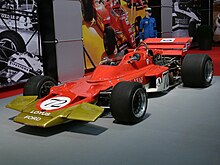Lotus 72



The Lotus 72 was a racing car designed and built by Colin Chapman and Maurice Philippe and used by the British Formula 1 team Lotus from 1970 to 1975 . The Lotus 72 is still considered to be one of the most successful Formula 1 cars of all time. It was used until 1975 (Lotus 72E) and in 1974 won three more Grands Prix with Ronnie Peterson . The technological forerunners of the Lotus 72 were the turbine Lotus and the all-wheel-drive Lotus 56 B. Many design details were used for the first time in Formula 1.
construction
The fairing was wedge-shaped, so the coolers were located in the side pods, where they allowed better weight distribution. The monocoque changed to a partially open, sheet-metal reinforced rectangular tube construction at the level of the front axle. It was necessary to reach the internal front brakes. The brake discs were vented through the typical small chimneys. The brakes were connected to the wheels by shafts - one of the weak points of the Lotus 72, because the connection between the brake discs and the shaft broke several times and was the trigger for Jochen Rindt's fatal accident .
Shock absorbers and the torsion bar springs used for reasons of space were located in the chassis. The shock absorbers were connected to the upper wishbones via a tie rod. The wishbones were triangular and made of sheet metal. The upper wishbones lay in the incline of the wedge shape, creating an anti-dive effect. This arrangement did not work and was soon rebuilt.
The cockpit fairing consisted of a one-piece plexiglass cladding that was placed on the chassis. Behind the driver, for the first time, most of the tank was placed in the center of the vehicle, an arrangement that prevailed and has been retained to this day.
The first rear wing unit, adopted from the 49C, had three staggered wings.
Overall, the Lotus 72 was an unusual design for its time, which broke new ground in many areas. Many design details, especially the chassis, turned out to be problematic and had to be changed.
Racing history
The Lotus 72 made its debut in the 1970 Spanish Grand Prix . He was driven by Jochen Rindt and John Miles . Rindt won four Grand Prix races with the 72 in 1970, but had little confidence in the car. He had a fatal accident while training for the Italian Grand Prix and Colin Chapman faced considerable criticism. The accident was triggered by the known critical connection between the brake disc and the semi-axle. Rindt's successor, the Brazilian Emerson Fittipaldi , won the US Grand Prix at the end of 1970 and thus posthumously secured Rindt the drivers' championship and Lotus the success with the constructors.
The Lotus 72 won 20 of the 75 races in which it was used. In addition to the two titles in 1970, there were two world championships in 1972, and in 1973 that of the constructors. Defending champion Emerson Fittipaldi won three races, young talent Ronnie Peterson even four, but the two took points away from each other, so Stewart became champion again and Fittipaldi moved to McLaren. In 1974 the multi-adjustable Lotus 76 was supposed to be the successor, but Lotus was busy again with too much and again used the 72E, which now had a wider track. In 1975 the 72 still had to be used. Only the Lotus 77 proved itself as a successor.
literature
- David Hodges: Racing cars from A – Z after 1945. Motorbuch-Verlag, Stuttgart 1994, ISBN 3-613-01477-7 .
- Pete Lyons: Lotus 72. Formula 1 Greats, London 2019, ISBN 978-1-91050-533-5 .
- Ian Wagstaff: Lotus 72 Manual: An Insight Into Owning, Racing and Maintaining Lotus's Legendary Formula 1 Car Haynes Publishing, London 2012, ISBN 978-0-85733-127-4 .

